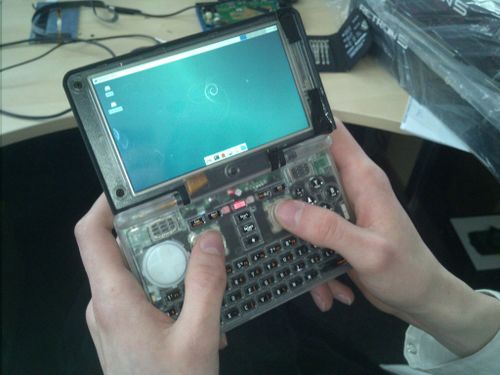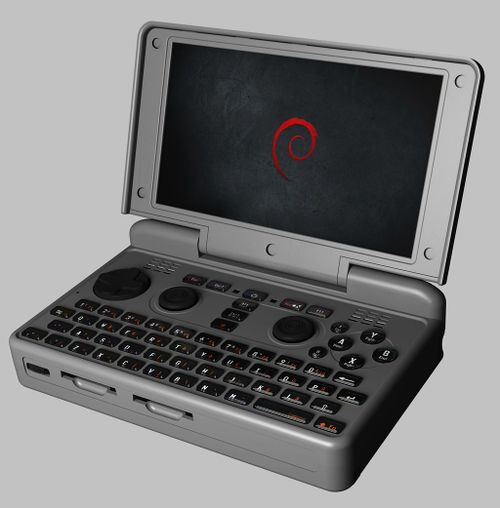Blaine0002 (talk | contribs) m (Wally moved page Dragonbox Pyra to Hardware overview without leaving a redirect) |
(Ensuring everything links from this overview) |
||
| Line 4: | Line 4: | ||
== | == Specifications == | ||
=== Case === | |||
Main article: [[Case]] | |||
* Polycarbonate case, 140 x 74 x 29 mm | |||
=== Input Devices === | === Input Devices === | ||
* Gaming controls (DPad, 4 shoulder buttons, 6 face buttons) | * Gaming controls (DPad, 4 shoulder buttons, 6 face buttons) | ||
| Line 14: | Line 18: | ||
=== Internals === | === Internals === | ||
* 6000mAh [[Battery]] | * 6000mAh [[Battery]] | ||
* 720p 5" LCD (Interchangeable in the Future) | * 720p 5" LCD [[Display]] (Interchangeable in the Future) | ||
* Vibration motor | * Vibration motor | ||
* Various | * Various [[Sensors]] (accelerometer, gyro-sensor, etc.) | ||
* | * Three PCBs; | ||
:* 2 or 4GB [[RAM]] | :* An interchangeable [[CPU-Board]]: | ||
:* Texas Instruments [[OMAP 5]] SoC: | ::* 2 or 4GB [[RAM]] | ||
::* 2x ARM Cortex-A15 @ 1.5Ghz with NEON SIMD | ::* Texas Instruments [[OMAP 5]] SoC: | ||
::* 2x ARM Cortex-M4 | :::* 2x ARM Cortex-A15 @ 1.5Ghz with NEON SIMD | ||
::* PowerVR™ SGX544-MP2 (see [[GPU]]) | :::* 2x ARM Cortex-M4 | ||
::* Vivante GC320 2D Accelerator | :::* PowerVR™ SGX544-MP2 (see [[GPU]]) | ||
:::* Vivante GC320 2D Accelerator | |||
::* 32MB of eMMC flash for the preinstalled OS | |||
:* A [[Mainboard]] where all peripherals connect | |||
:* and a [[Displayboard]] which interfaces the [[Display]] and the [[Touchscreen]] to the hinge cable (which connects the case lid components to the [[Mainboard]]) | |||
=== Connectivity === | === Connectivity === | ||
* Integrated [[WiFi|Wi-Fi]] 802.11a/b/g/n and [[Bluetooth]] 4.1 | * Integrated [[WiFi|Wi-Fi]] 802.11a/b/g/n and [[Bluetooth]] 4.1 | ||
* Optional 3G/4G/UMTS [[Modem]] and [[GPS]] | * Optional 3G/4G/UMTS [[Modem]] and [[GPS]] | ||
* Headset-Port | * [[Headset-Port|Audio]] | ||
* 1x HDMI Video Out | * 1x HDMI Video Out | ||
* 2x Full-size USB Host (one can be used as eSATA with a small [[ESATA_Adapter|Adapter]]) | * [[USB]] ports, permitting many [[Peripherals]] to be connected: | ||
* 1x Micro USB 3.0 OTG | :* 2x Full-size USB 2.0 Host (one can be used as eSATA with a small [[ESATA_Adapter|Adapter]]) | ||
* 1x Micro USB (Debug and Charging) | :* 1x Micro USB 3.0 OTG | ||
:* 1x Micro USB (Debug and Charging) | |||
* Status [[LEDs]] | |||
=== [[Storage]] | === Storage === | ||
* Internal eMMC | Main article: [[Storage]] | ||
* 32MB Internal eMMC | |||
* 1x Internal MicroSDHC Slot | * 1x Internal MicroSDHC Slot | ||
* Dual SDXC card slots | * Dual SDXC card slots | ||
Revision as of 00:42, 8 August 2017


The Pyra is a perfect pocket device for everyday computing, gaming, emulation or hacking. It is a unique combination of a gaming handheld and a mini-laptop (approximately the size of the original Gameboy), running plain Debian Linux as OS. It is the successor of the OpenPandora.
Specifications
Case
Main article: Case
- Polycarbonate case, 140 x 74 x 29 mm
Input Devices
- Gaming controls (DPad, 4 shoulder buttons, 6 face buttons)
- Two accurate analog controls (Nubs) with push-button
- QWERTY Keyboard with backlight
- Touchscreen
- Analog volume wheel
Internals
- 6000mAh Battery
- 720p 5" LCD Display (Interchangeable in the Future)
- Vibration motor
- Various Sensors (accelerometer, gyro-sensor, etc.)
- Three PCBs;
- An interchangeable CPU-Board:
-
- 2x ARM Cortex-A15 @ 1.5Ghz with NEON SIMD
- 2x ARM Cortex-M4
- PowerVR™ SGX544-MP2 (see GPU)
- Vivante GC320 2D Accelerator
- 32MB of eMMC flash for the preinstalled OS
- A Mainboard where all peripherals connect
- and a Displayboard which interfaces the Display and the Touchscreen to the hinge cable (which connects the case lid components to the Mainboard)
Connectivity
- Integrated Wi-Fi 802.11a/b/g/n and Bluetooth 4.1
- Optional 3G/4G/UMTS Modem and GPS
- Audio
- 1x HDMI Video Out
- USB ports, permitting many Peripherals to be connected:
- 2x Full-size USB 2.0 Host (one can be used as eSATA with a small Adapter)
- 1x Micro USB 3.0 OTG
- 1x Micro USB (Debug and Charging)
- Status LEDs
Storage
Main article: Storage
- 32MB Internal eMMC
- 1x Internal MicroSDHC Slot
- Dual SDXC card slots


